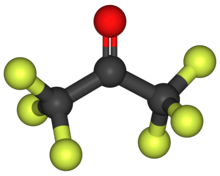 | |
 | |
| Names | |
|---|---|
| Preferred IUPAC name 1,1,1,3,3,3-Hexafluoropropan-2-one | |
| Other names
perfluoroacetone acetone hexafluoride perfluoro-2-propanone | |
| Identifiers | |
| CAS Number | |
| 3D model (JSmol) | |
| ChEBI | |
| ChemSpider | |
| ECHA InfoCard | 100.010.616 |
| EC Number |
|
| PubChem CID | |
| RTECS number |
|
| UNII | |
| UN number | 2420 |
| CompTox Dashboard (EPA) | |
InChI
| |
SMILES
| |
| Properties | |
| Chemical formula | C3F6O |
| Molar mass | 166.02 g/mol |
| Appearance | Colorless gas |
| Odor | musty |
| Density | 1.32 g/ml, liquid |
| Melting point | −129 °C (144 K) |
| Boiling point | −28 °C (245 K) |
| Solubility in water | Reacts with water |
| Vapor pressure | 5.8 atm (20 °C) |
| Hazards | |
| Occupational safety and health (OHS/OSH): | |
| Main hazards | Toxic (T), Corrosive (C) |
| GHS labelling: | |
| Pictograms |    
|
| Signal word | Danger |
| Hazard statements | H301, H310, H311, H314, H315, H330, H360, H370, H372 |
| Precautionary statements | P201, P202, P260, P262, P264, P270, P271, P280, P281, P284, P301+P310, P301+P330+P331, P302+P350, P302+P352, P303+P361+P353, P304+P340, P305+P351+P338, P307+P311, P308+P313, P310, P312, P314, P320, P321, P322, P330, P332+P313, P361, P362, P363, P403+P233, P405, P410+P403, P501 |
| NFPA 704 (fire diamond) |
 |
| Flash point | Nonflammable |
| NIOSH (US health exposure limits): | |
| PEL (Permissible) | none |
| REL (Recommended) | TWA 0.1 ppm (0.7 mg/m) |
| IDLH (Immediate danger) | N.D. |
| Related compounds | |
| Related ketones; organofluorides |
Acetone; Hexafluoro-2-propanol |
| Except where otherwise noted, data are given for materials in their standard state (at 25 °C , 100 kPa).
| |
Hexafluoroacetone (HFA) is a chemical compound with the formula (CF3)2CO. It is structurally similar to acetone; however, its reactivity is markedly different. It is a colourless, hygroscopic, nonflammable, highly reactive gas characterized by a musty odour. According to electron diffraction, HFA and acetone adopt very similar structures, the C-O distance being only longer in the fluorinated compound (124.6 vs 121.0 pm), possibly due to steric effects.
The term "hexafluoroacetone" can refer to the sesquihydrate (1.5 H2O), which is a hemihydrate of hexafluoropropane-2,2-diol (F
3C)
2C(OH)
2, a geminal diol. Hydrated HFA behaves differently from the anhydrous material.
Synthesis
The industrial route to HFA involves treatment of hexachloroacetone with HF (a Finkelstein reaction):
- (CCl3)2CO + 6 HF → (CF3)2CO + 6 HCl
Laboratory methods
Hydrated HFA can be converted to HFA by treatment with hot sulfuric acid.
It has also be prepared from hexafluoropropylene oxide, which will rearrange to give HFA when heated in the presence of a Lewis acid such as AlCl3. The Lewis acid catalysed oxidation of hexafluoropropylene will also produce HFA, via a similar mechanism.
Although it is commercially available, HFA can be prepared on the laboratory-scale from hexafluoropropylene. In the first step KF catalyzes the reaction of the alkene with elemental sulfur to give the 1,3-dithietane dimer of hexafluorothioacetone. This species is then oxidized by potassium iodate to give HFA.
Uses
Hexafluoroacetone is used in the production of hexafluoroisopropanol:
- (CF3)2CO + H2 → (CF3)2CHOH
It is also used as a precursor to hexafluoroisobutylene, a monomer used in polymer chemistry, and as a building block in the synthesis of midaflur, bisphenol AF, 4,4′-(hexafluoroisopropylidene)diphthalic anhydride, and alitame.
Reactivity


With water, hexafluoroacetone converts to the hydrate. The equilibrium constant (Keq) for the formation of this geminal diol is 10 M. The analogous equilibrium for acetone is an unfavorable 10 M. Hexafluoroacetone-hydrates are acidic. In an analogous reaction, ammonia adds to hexafluoroacetone to give the hemiaminal (CF3)2C(OH)(NH2) which can be dehydrated with phosphoryl chloride to give the imine (CF3)2CNH.
Nucleophiles attack occurs at the carbonyl carbon of Hexafluoroacetone, as illustrated above. Thus, HFA readily forms lactones when treated with hydroxy- and amine-substituted carboxylic acids. In such reactions, HFA serves both as electrophile and dehydrating agent:
- RCH(OH)CO2H + O=C(CF3)2 → RCH(O)CO2C(CF3)2 + (HO)2C(CF3)2
See also
References
- ^ NIOSH Pocket Guide to Chemical Hazards. "#0319". National Institute for Occupational Safety and Health (NIOSH).
- CDC - NIOSH Pocket Guide to Chemical Hazards
- Hilderbrandt, R. L.; Andreassen, A. L.; Bauer, Simon Harvey (1970). "Electron diffraction investigation of hexafluoroacetone, hexafluoropropylimine, and hexafluoroisobutene". The Journal of Physical Chemistry. 74 (7): 1586–1592. doi:10.1021/j100702a030.
- ^ Günter Siegemund; Werner Schwertfeger; Andrew Feiring; Bruce Smart; Fred Behr; Herward Vogel; Blaine McKusick (2002). "Fluorine Compounds, Organic". Ullmann's Encyclopedia of Industrial Chemistry. Weinheim: Wiley-VCH. doi:10.1002/14356007.a11_349.
- ^ Spengler, Jan; Böttcher, Christoph; Albericio, Fernando; Burger, Klaus (2006). "Hexafluoroacetone as Protecting and Activating Reagent: New Routes to Amino, Hydroxy, and Mercapto Acids and Their Application for Peptide and Glyco- and Depsipeptide Modification". Chemical Reviews. 106 (11): 4728–4746. doi:10.1021/cr0509962. PMID 17091933.
- Millauer, Hans; Schwertfeger, Werner; Siegemund, Günter (March 1985). "Hexafluoropropene Oxide — A Key Compound in Organofluorine Chemistry". Angewandte Chemie International Edition in English. 24 (3): 161–179. doi:10.1002/anie.198501611.
- Anello, Louis G.; Van der Puy, Michael (January 1982). "A convenient synthesis of hexafluoroacetone". The Journal of Organic Chemistry. 47 (2): 377–378. doi:10.1021/jo00341a046.
- Van Der Puy, M.; Anello, L. G. (1985). "Hexafluoroacetone". Organic Syntheses. 53: 154. doi:10.15227/orgsyn.063.015.
- Lemal, David M. (2004). "Perspective on Fluorocarbon Chemistry". The Journal of Organic Chemistry. 69 (1): 1–11. doi:10.1021/jo0302556. PMID 14703372.
- W. J. Middleton; H. D. Carlson (1970). "Hexafluoroacetone imine". Org. Syntheses. 50: 81–3. doi:10.15227/orgsyn.050.0081..